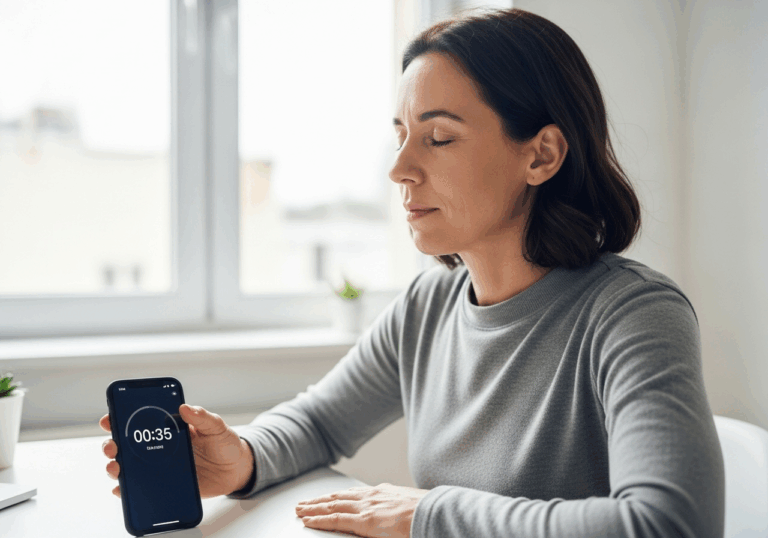Science-Backed Tips
Reduce Public Speaking Anxiety with VR Therapy
Self-guided VR sessions cut anxiety by 30% in adolescents.
📊 Did you know?
💡 Why It Matters
1️⃣
Accessible VR exposure therapy can significantly improve emotional control in adolescents.
2️⃣
Long-term anxiety reductions can enhance overall quality of life and academic performance.
3️⃣
Cost-effective self-guided interventions may reduce the need for therapist-led sessions.
✅ Try These Micro-Tips
🎯
Engage in 15 self-guided VR sessions, 2 minutes each, over 3 weeks.
🎯
Practice public speaking tasks in a safe virtual environment weekly.
🎯
Monitor your anxiety levels before and after each session to track progress.
🎯
Consider combining VR therapy with mindfulness practices for enhanced results.
📚 The study
The study involved participants engaging in weekly VR public speaking tasks, totaling 15 sessions of 2 minutes each over a span of three weeks.
The results were promising, revealing significant self-reported reductions in anxiety that were maintained for up to 6 to 12 months post-therapy.
This is particularly important as accessible VR exposure therapy not only enhances emotional control but also contributes to long-term mood stability.
By providing a cost-effective alternative to traditional therapist-led sessions, self-guided interventions can empower adolescents to manage their anxiety more effectively, ultimately leading to improved quality of life and better academic performance.
As mental health continues to be a pressing issue among young people, the findings from this study underscore the potential of innovative therapeutic approaches like VRET to make a meaningful difference in the lives of those struggling with anxiety disorders.
❓ Frequently Asked Questions ❓
Learn more
What is VR exposure therapy (VRET)?
VR exposure therapy (VRET) is a therapeutic approach that uses virtual reality technology to simulate real-life situations for individuals to confront their fears. It allows users to practice coping strategies in a controlled environment, which can lead to reduced anxiety over time.
How does self-guided VRET compare to therapist-led interventions?
Research indicates that self-guided VRET can reduce public speaking anxiety in adolescents to a degree similar to that of therapist-led interventions. This makes it a viable alternative for those seeking accessible treatment options.
How long should adolescents engage in VRET sessions?
Adolescents should complete 15 self-guided VR sessions, each lasting 2 minutes, over a span of 3 weeks. This structured approach helps to gradually build confidence and reduce anxiety.
What are the benefits of using VR for public speaking practice?
Practicing public speaking in a virtual environment allows adolescents to face their fears without the pressure of a real audience. This safe space can lead to significant improvements in emotional control and self-confidence.
How long do the effects of VRET last?
Self-reported reductions in anxiety from VRET have been sustained for up to 6–12 months after completing the sessions. This indicates that the benefits of the therapy can have a lasting impact on emotional well-being.
Can VRET improve academic performance?
Yes, long-term reductions in anxiety can enhance overall quality of life, which may positively influence academic performance. By reducing anxiety, students may feel more confident and focused in their studies.
Is VRET cost-effective?
Self-guided VRET is considered a cost-effective intervention, potentially reducing the need for therapist-led sessions. This makes it an accessible option for many adolescents seeking help for anxiety.
Should I monitor my anxiety levels during VRET?
Yes, it is recommended to monitor your anxiety levels before and after each session to track progress. This self-assessment can help you understand the effectiveness of the therapy and adjust your approach if needed.
Can mindfulness practices enhance the results of VRET?
Combining VR therapy with mindfulness practices may lead to enhanced results in managing anxiety. Mindfulness can help individuals develop greater emotional awareness and coping strategies alongside their VR exposure.
Who can benefit from self-guided VRET?
Self-guided VRET is particularly beneficial for adolescents experiencing public speaking anxiety or specific phobias. It provides a flexible and effective way to confront fears and improve emotional regulation.





